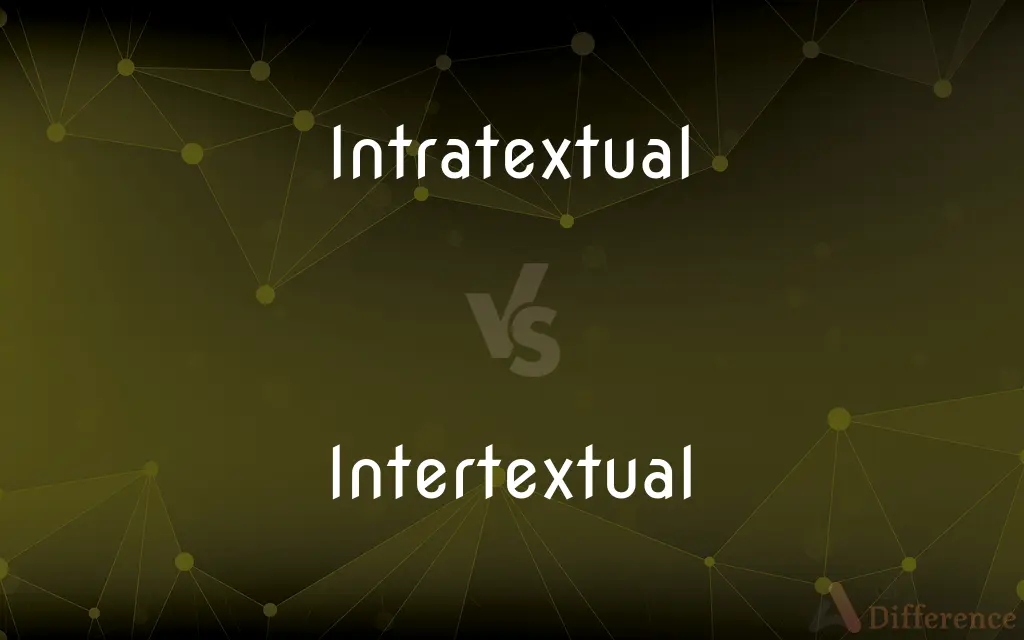Intratextual vs. Intertextual — What's the Difference?
By Fiza Rafique & Urooj Arif — Updated on March 22, 2024
Intratextual analysis focuses on elements within a single text, exploring its structure and meaning. Intertextual analysis examines connections between different texts, highlighting influences and references.

Difference Between Intratextual and Intertextual
Table of Contents
ADVERTISEMENT
Key Differences
Intratextual analysis delves into the specifics of a single text, examining its themes, structure, stylistic features, and the relationship between its various parts. On the other hand, intertextual analysis steps outside the confines of a single text to explore how it relates to, interacts with, or is influenced by other texts.
While intratextual analysis might focus on how a character’s development reflects the central theme of a novel or how the use of a specific narrative technique affects the reader's understanding of the text, intertextual analysis could explore how a novel mirrors themes from classical literature or references historical events to deepen its narrative. Intratextuality is concerned with the coherence and unity of the text itself, whereas intertextuality reveals a text’s connectivity to a broader literary and cultural context.
The study of intratextuality allows readers and scholars to gain a deep and nuanced understanding of a text, considering its unique qualities and internal mechanisms. This can involve close readings, where the focus is on details such as word choice, sentence structure, and motifs. Intertextuality, by contrast, invites a more comparative approach, encouraging the identification of direct quotes, allusions, stylistic imitations, and thematic parallels with other works. It highlights how texts are not isolated but are part of an ongoing cultural and literary conversation.
An intratextual analysis might reveal, for example, how the repetition of a certain phrase in a text contributes to its overall mood or theme. In contrast, an intertextual analysis might show how that same phrase, when viewed in light of another text, adds layers of meaning or alters our interpretation of the original work. Intratextuality emphasizes the self-contained artistry and meaning of a text, while intertextuality points to its interconnectedness and the ways it can be enriched or informed by other texts.
In practice, intratextual analysis is crucial for a detailed appreciation of a text’s craftsmanship and for understanding its standalone meaning and aesthetic value. Intertextual analysis, however, is essential for situating a text within a larger literary and cultural landscape, illustrating how texts draw from and contribute to shared cultural narratives, themes, and ideas. Both approaches offer valuable insights, but they differ significantly in their focus and methodologies.
ADVERTISEMENT
Comparison Chart
Focus
Internal elements of a single text.
Connections between different texts.
Key Considerations
Structure, themes, style within the text.
References, allusions, influences among texts.
Purpose
To understand a text’s unique qualities.
To explore textual relationships and influences.
Analytical Approach
Close reading and analysis of text itself.
Comparative analysis of texts.
Outcome
Insight into text's meaning and structure.
Understanding of texts in a broader context.
Compare with Definitions
Intratextual
Study of how parts of a text relate to the whole.
Intratextual scrutiny showed how the opening scene foreshadowed the climax.
Intertextual
Involving connections between different texts.
The intertextual analysis showed how the novel draws on ancient myths.
Intratextual
Pertaining to the elements within a single text.
The intratextual analysis revealed the novel’s complex narrative structure.
Intertextual
Comparison of themes across different texts.
Intertextual comparison highlighted shared themes of rebellion in literature.
Intratextual
Examination of stylistic features within a text.
An intratextual look at the dialogue highlighted the author’s unique voice.
Intertextual
Study of how texts reference or influence each other.
An intertextual approach revealed parallels between two authors’ works.
Intratextual
Analysis focusing on a text's own content and structure.
Through intratextual examination, the poem's recurring motifs were identified.
Intertextual
Analysis of how texts are interconnected.
The paper traced the intertextual lineage of modernist poetry.
Intratextual
Investigation of themes within the same text.
The play’s intratextual themes of betrayal were explored in depth.
Intertextual
Exploration of allusions to other works within a text.
The film’s intertextual references to classic cinema enriched its narrative.
Intratextual
Within a single text.
Intertextual
Relating to or deriving meaning from the interdependent ways in which texts stand in relation to each other.
Intertextual
Pertaining to intertextuality; being or involving the reference to one text in another.
Common Curiosities
How do intratextuality and intertextuality differ in literary studies?
Intratextuality focuses on a text's internal aspects, while intertextuality examines how texts relate to and influence each other.
Why is intratextual analysis important?
It allows for a deep understanding of a text’s unique structure, themes, and stylistic elements.
What does intertextual analysis focus on?
Intertextual analysis explores the relationships, influences, and references between different texts.
Can a text be both intratextually and intertextually analyzed?
Yes, analyzing a text both intratextually and intertextually can provide comprehensive insights into its standalone significance and its connections to other works.
What are examples of intertextual elements?
References, allusions, quotations, genre similarities, and thematic parallels between texts.
What is intratextual analysis?
Intratextual analysis examines the internal elements, themes, and structure of a single text.
What is the purpose of intertextual analysis?
To understand how texts interact within the broader cultural and literary landscape, highlighting influences and shared themes.
Can intertextuality affect a reader's interpretation of a text?
Yes, recognizing intertextual connections can significantly enrich and sometimes alter the interpretation of a text.
How do intratextual and intertextual analyses contribute to literary criticism?
They offer complementary insights: intratextual analysis for appreciating a text's internal coherence and uniqueness, and intertextual for understanding its cultural and literary context.
Is intratextual analysis limited to literary texts?
No, intratextual analysis can apply to any form of text, including film, art, and multimedia, focusing on its internal aspects.
Share Your Discovery

Previous Comparison
Meteor vs. Meteorite
Next Comparison
Marketing vs. MarketAuthor Spotlight
Written by
Fiza RafiqueFiza Rafique is a skilled content writer at AskDifference.com, where she meticulously refines and enhances written pieces. Drawing from her vast editorial expertise, Fiza ensures clarity, accuracy, and precision in every article. Passionate about language, she continually seeks to elevate the quality of content for readers worldwide.
Co-written by
Urooj ArifUrooj is a skilled content writer at Ask Difference, known for her exceptional ability to simplify complex topics into engaging and informative content. With a passion for research and a flair for clear, concise writing, she consistently delivers articles that resonate with our diverse audience.















































